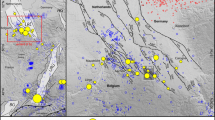Abstract
The Pinjore Garden Fault (PGF) striking NNW-SSE is now considered one of the active faults displacing the younger Quaternary surfaces in the piggyback basin of Pinjore Dun. This has displaced the older Kalka and Pinjore surfaces, along with the other younger surfaces giving rise to WSW and SW-facing fault scarps with heights ranging from 2 to 16 m. The PGF represents a younger branch of the Main Boundary Thrust (MBT) system. An ~ 4m wide trench excavated across the PGF has revealed displacement of younger Quaternary deposits along a low angle thrust fault. Either side of the trench-walls reveals contrasting slip-related deformation of lithounits. The northern wall shows displacement of lithounits along a low-angle thrust fault, while the southern wall shows well-developed fault-related folding of thick sand unit. The sudden change in the deformational features on the southern wall is an evidence of the changing fault geometry within a short distance. Out of five prominent lithounits identified in the trench, the lower four units show displacement along a single fault. The basal unit ‘A’ shows maximum displacement of aboutT o = 2.85 m, unit B = 1.8 m and unit C = 1.45 m. The displacement measured between the sedimentary units and retro-deformation of trench log suggests that at least two earthquake events have occurred along the PGF. The units A and D mark the event horizons. Considering the average amount of displacement during one single event (2 m) and the minimum length of the fault trace (~ 45 km), the behaviour of PGF seems similar to that of the Himalayan Frontal Fault (HFF) and appears capable of producing large magnitude earthquakes.
Similar content being viewed by others
References
Ambraseys N and Bilham R 2000 A note on the Kangra Ms = 7.8 earthquake of 4 April 1905;Curr. Sci. 79 45–50.
Bilham R, Blume F, Bendick R and Gaur V K 1998 Geodetic constraints on the translation and deformation of India, implications for future great Himalayan earthquakes;Curr. Sci. 74 213–229.
Bilham R, Gaur V K and Molnar P 2001 Himalayan Seismic Hazard;Science 293 1442–1444.
Burbank D W and Reynolds R G H 1988 Stratigraphic keys to the timing of thrusting in terrestrial foreland basins: Applications to the northwestern Himalaya; In: New Prospective in basin analysis: KleinspehnK L and Paola C (eds) (New York: Springer-Verlag), Pp. 331–351.
Khattri K N and Tyagi A K 1983 Seismicity patterns in the Himalayan plate boundary and identification of areas of high seismic potential;Tectonophys. 96 281–297.
Kumar S, Wesnosusky W G, Rockwell T K, Ragona D, Thakur V C and Seitz G G 2001 Earthquake Recurrence and Rupture Dynamics of Himalayan Frontal Thrust, India;Science 294 2328–2331.
Malik J N and Nakata T 2003 Active faults and related Late Quaternary deformation along the northwestern Himalayan Frontal Zone, India;Anna. Geophys. 46 917–936.
Malik J N, Nakata T, Philip G and Virdi N S 2003 Preliminary observations from trench near Chandigarh, NW Himalaya and their bearing on active faulting;Curr. Sci. 85 1793–1799.
McCalpin J P 1996Paleoseismology; Academic Press, New York, p. 588.
Meghraoui M, Philip H, Albarede F and Cisternas A 1988 Trench investigations through the trace of the 1980 El Asnam Thrust Fault: Evidence for paleoseismicity;Bull. Seism. Soc. Am. 78 979–999.
Nakata T 1989 Active faults of the Himalaya of India and Nepal;Geol. Soc. Am., Sp. Pap. 232 243–264.
Oatney E M, Virdi N S and Yeats R S 2001 Contribution of Trans-Yamuna Active Fault System towards Hanging wall strain release above the décollement, Himalayan Foothills of Northwest India;Him. Geol. 22 9–27.
Ori G and Frined P F 1984 Sedimentary basins formed and carried piggyback on active thrust sheets;Geology 12 475–478.
Outtani F, Addoum B, Mercier E, Lamotte D and Andrieux J 1995 Geometry and kinematics of the South Atlas Front, Algeria and Tunisia;Tectonophys. 249 233–248.
Philip H, Rogozhin E, Cisternas A, Bousquet J C, Borisov B and Karakhanian A 1992 The Armenian earthquake of 1988 December 7; faulting and folding, neotectonics and paleoseismicity;Geophys. Int. 110 141–158.
Seeber L and Armbruster J G 1981 Great detachment earthquakes along the Himalayan arc and long-term forecasting; In: Earthquake Prediction — An international Review, Simpson D W and Richards P G (eds) AGU. 259–279.
Suppe J 1983 Geometry and kinematics of fault-bend folding;Am. J. Sci. 283 684–721.
Suppe J and Medwedeff D A 1990 Geometry and kinematics of fault-propagation folding;Ecologae Geol. Helv. 83 409–454.
Valdiya K S 2001 Reactivation of terrain-defining boundary thrusts in central sector of the Himalaya: Implications;Curr. Sci. 81 1418–1431.
Yeats R S and Thakur V C 1998 Reassessment of earthquake hazard based on a fault-bend fold model of the Himalayan plate-boundary fault;Curr. Sci. 74 230–233.
Yeats R S, Sieh K and Allen C R 1997.Geology of Earthquakes; Oxford Univ. Press, p. 568.
Author information
Authors and Affiliations
Rights and permissions
About this article
Cite this article
Malik, J.N., Mathew, G. Evidence of paleoearthquakes from trench investigations across Pinjore Garden fault in Pinjore Dun, NW Himalaya. J Earth Syst Sci 114, 387–400 (2005). https://doi.org/10.1007/BF02702139
Received:
Accepted:
Issue Date:
DOI: https://doi.org/10.1007/BF02702139




